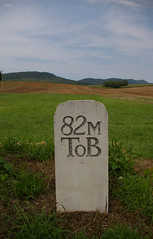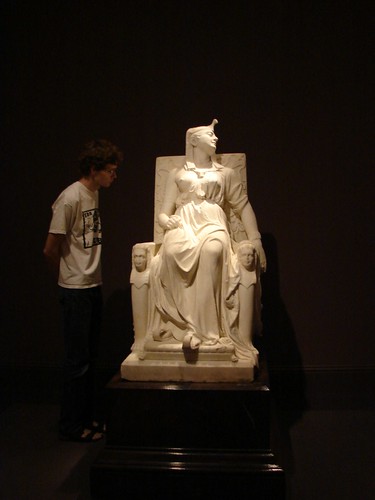I also work as an editor over on the Historical Marker Database. It seemed that it might be an interesting idea to not just map historical markers related to the National Road, which we've done, in this series, but also markers merely in the vicinity of the National Road. The following are the historical markers on or near the National Road, in Maryland, for Garrett County and Allegany County.
Look for additional counties in future posts.
Tuesday, April 29, 2008
Saturday, March 22, 2008
Polish Mountain

Polish Mountain is on the National Road, about two miles east of Flintstone, Maryland, in Allegany County. The route of the road on the east side, Maryland State Route 144, remains relatively unchanged. This photograph, taken in 1921, illustrates the east face of the mountain quite well.

The route that is signed as the National Road Scenic Byway, differs somewhat on the western side of the mountain. In 1958, Route 40 (now Maryland 144) removed many of the curves on the National Road for a much easier drive. The old alignment of the National Road is now known as Gilpin Road NE, and provides for a much more fun drive, though it does have fewer places to stop and take photographs, due to very narrow or nonexistent shoulders. This tablet, erected in 1958, is just west of the turnoff for Gilpin Road.

The view from the top of Polish Mountain can be quite spectacular. Below, I-68 cuts across the landscape.
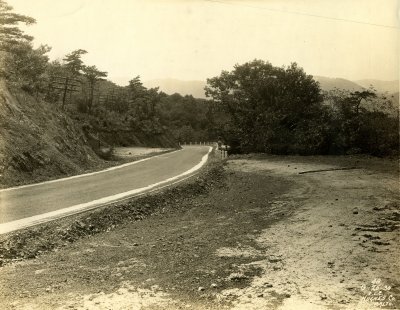
This realignment is just the summit, as seen looking west. Note the "lighthouse", on the right side of the road, near the curve, warning motorists to slow down. On the old path of the road, to the left, one can see a vertical bar with diagonal stripes, also warning motorists to slow down.
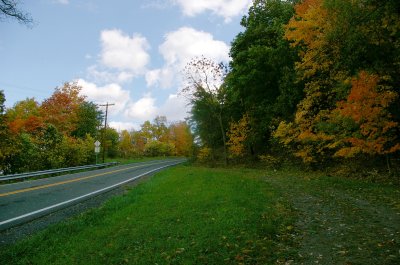
Seventy five years later, the landscape has changed little. This view shows the same realignment, but as seen from the opposite direction.
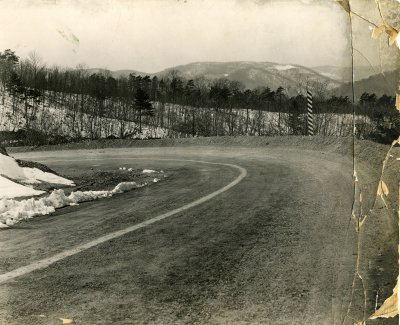
The road west from the summit of Polish Mountain was a difficult one. Some period postcards claimed "17 curves," many with sharp drop-offs like this one. The vertical bar with the diagonal stripes was a sort of warning sign, indicating a situation where motorists might need to slow down.
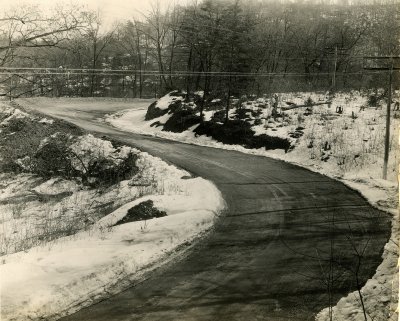
More curves like this one presented themselves as the motorist continued down the mountain. June 1932?
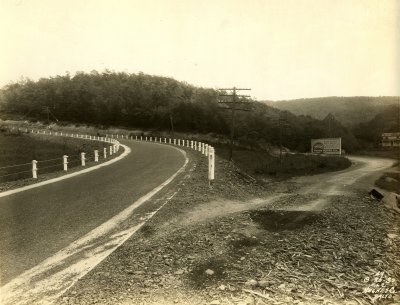
This photo is at the foot of the west slope Polish Mountain looking east showing relocation of the road and the new guard rail. The billboard on the old alignment is for Amoco Motor Oil. It reads "Low cost per mile is what counts!"
Some of the realignments discussed above are illustrated on this map.
All black and white photographs are used courtesy of the Enoch Pratt Free Library, Central Library / State Library Resource Center, Baltimore, Maryland. All black and white photographs are by the Maryland State Roads Commission, except for the first one, which is by the Maryland State Department of Forestry.
The Fairview Inn
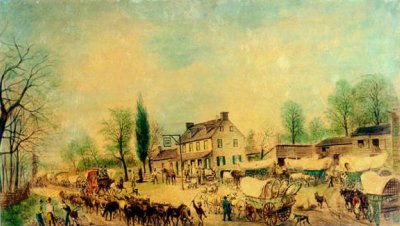
The Fairview Inn, at milestone 3 on the National Road in Baltimore, is probably best known for its place in this print, in the Cator Print Collection at the Enoch Pratt Free Library, in Baltimore.
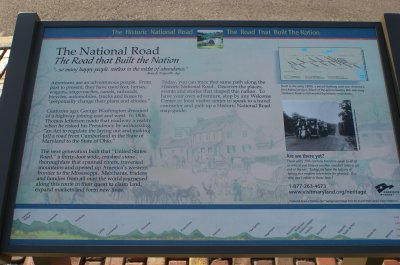
It has been used as the background for all of the National Road historical markers erected by America's Byways in Maryland. The one shown here is the general introductory marker, used in many places around the state, here at the B&O Railroad Museum in Baltimore.
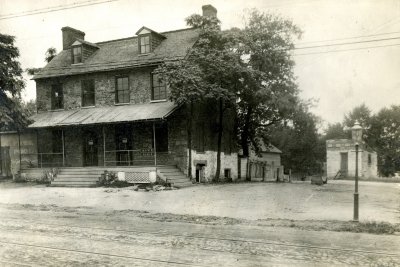
This is the only known photograph of the Inn, which was demolished in the 1920s. Some versions of the photograph crop the image a bit wider, to include the milestone, which is just to the right of what you see here. This image is believed to have been made by T. C. Worthington, Jr., circa 1900. (Courtesy of the Enoch Pratt Free Library, Central Library / State Library Resource Center, Baltimore, Maryland.)
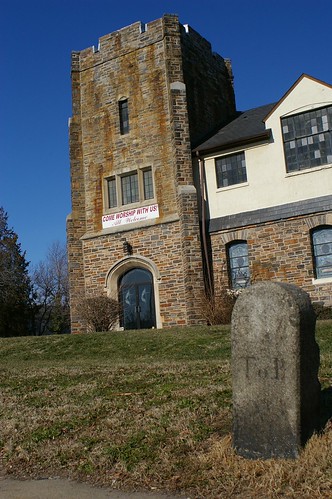
This is the same site, as seen today.
Friday, March 7, 2008
Stackhouse Family Cemetery, Howard County
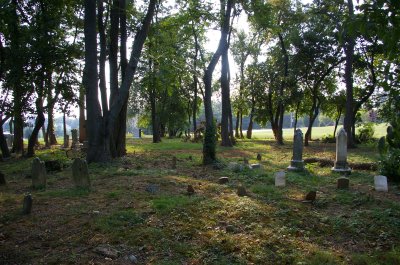
This seemingly abandoned cemetery sits on the old National Road, two and a half miles west of Lisbon, in Howard County, Maryland. Last names include Stackhouse, Webb, Owings, Hood, Delawder, Burdette and others. Most are from the middle third of the 19th century, though I noticed some as recent as the second quarter of the 20th century.
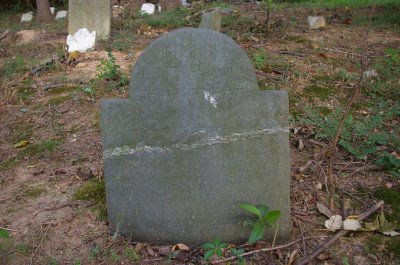
One of the more curious stones was this one, which appears to be carved from slate. I could not make out the inscription.
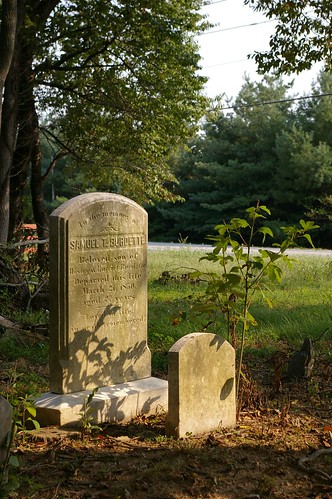
Samuel T. Burdette - Departed this life March 21, 1850, aged 27 years.
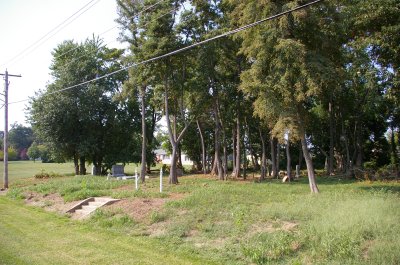
The cemetery is on the right side of the road, when traveling west. More photographs of the site can be found over on my Flickr account, in the set Stackhouse Family Cemetery.
The Construction of the Gwynns Falls Bridge
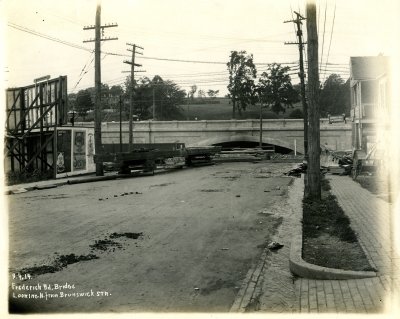
The new bridge, as seen from the south, looking north.
In 1914, a new, concrete arch bridge replaced the existing one over the Gwynns Falls in Baltimore.
These four photographs, all courtesy of the Enoch Pratt Free Library, Central Library / State Library Resource Center, Baltimore, Maryland, document the construction of the new bridge.
This map illustrates the locations from which the photographs were taken. If you click on the cameras, you can see the historical photographs shot from that approximate location.
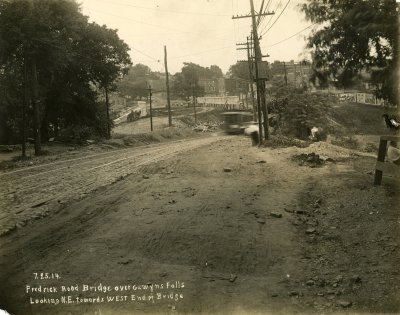
Streetcar passing over the old bridge over Gwynns Falls, with the new bridge in the background.
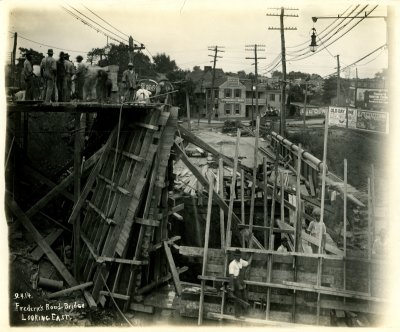
This image was taken at about the same angle as the one above, but much closer.

The bridges, as seen from the south.
Wednesday, March 5, 2008
Milestone?
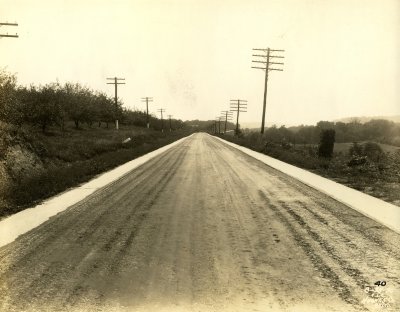
This 1920s or 1930s photograph, by the Maryland State Roads Commission, shows the area east of Hancock looked like before I-70 was cut through. The spot is on the National Road, about two miles east of Hancock, as seen from the west, looking east. Fruit orchards, like those on the left were plentiful.
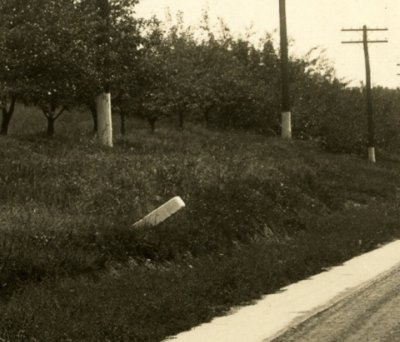
The white object on the left side of the road, enlarged here, appears to be milestone 95 M to B. This milestone, along with 94 and 93, sit in the median of I-70, close to their original positions. Due to a relatively narrow shoulder and large quantity of traffic, I have not been able to obtain a photograph of milestone 95 to acertain that it is, in fact, what is pictured here.
Photograph used courtesy of the Enoch Pratt Free Library, Central Library / State Library Resource Center, Baltimore, Maryland.
Road relocation at Puzzley Run
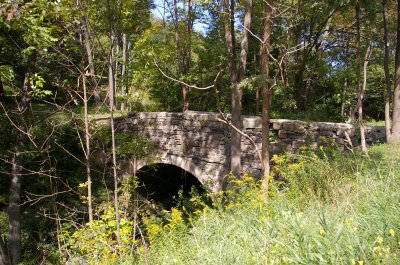
The stone bridge at Puzzley (sometimes Puzzly) Run, west of Grantsville, Maryland, came up briefly once before, but I never wrote much, primarily because there was nothing to write - I couldn't reconcile the path of the road today, the bridge, and the previous alignment.
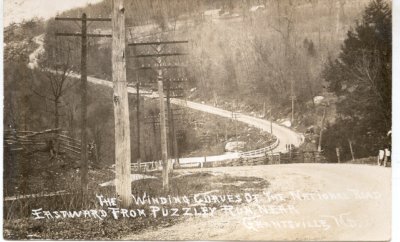
This turn of the century postcard shows the bridge, between the two curves of the road, as seen from a bit farther west.
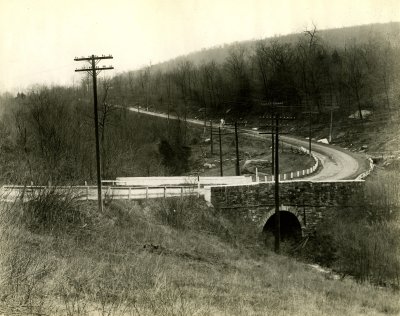
This is the south side of the bridge, the same one shown in the color photograph above. It was probably taken in the 1920s, by the Maryland State Roads Commission.
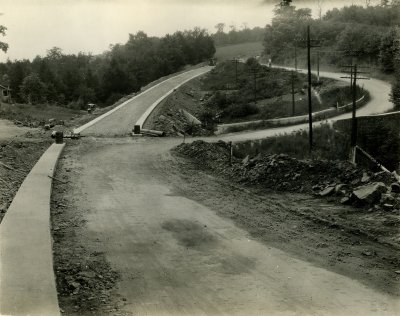
This view, looing west, shows the stone bridge on the right and the new alignment of the road on the left. 19th century bridge builders tended to take the straightest path possible across a stream, as it was cheaper and easier to build bridges this way. Automobiles, travelling at higher speeds, could not easily navigate these sharp curves, so in 1932, the road was straightened, eliminating this bridge. Photograph by the Maryland State Roads Commission, September, 1932.
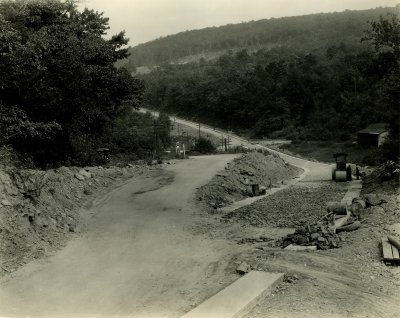
This view, looking east toward Grantsville, is from almost the same location as the black and white postcard above. Photograph by the Maryland State Roads Commission, September, 1932.
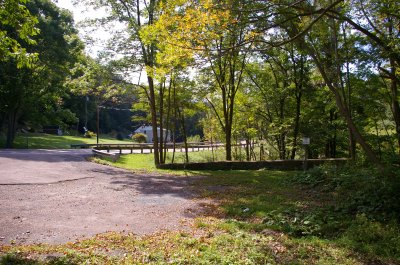
This photograph, taken last summer, shows the current route of Route 40. The structure that appears to be a stone wall, in the center of the picture, is the south side of the bridge.

The bridge has deteriorated rather considerably. Little remains of the north side. The west end of the south wall is lacking. Still, given that the bridge is probably 180 years old and that it hasn't had any maintenance for at least the past 90 years, it looks quite good. It appeast to be structurally sound, and may still be in use, as a driveway to a private residence.
The three photographs by the State Roads Commission are used courtesy of the Enoch Pratt Free Library, Central Library / State Library Resource Center, Baltimore, Maryland.
Missing Milestone
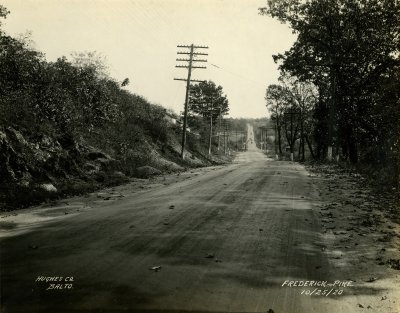
Courtesy of the Enoch Pratt Free Library, Central Library / State Library Resource Center, Baltimore, Maryland
I don't know where it is today, but Milestone 32 M to B (just west of Mt. Airy, Maryland) sat on the National Road until at least 1920, as seen here in this photograph from the State Roads Commission.

The milestone is just behind the second mailbox, in this englargement of the photo.
This particular bit of roadscape remains surprisingly similar today. There is still no signal at the railroad crossing and the landscape remains much the same, but with a few more trees.
Thursday, February 28, 2008
The Old Bank Road Toll House, west of Hancock, Maryland
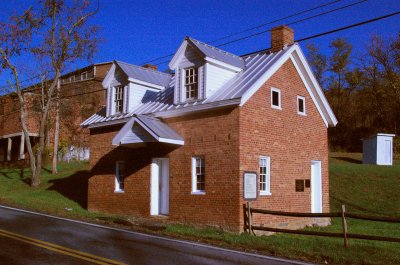
I've always been curious about the row of joists on the front of the Bank Road toll House, on the National Road, just west of Hancock, Maryland, at the western edge of Washington County. There was just something about them that felt wrong. Additionally, the tollhouse seemed too close to the road.

The joists can be seen a bit better in this detail, taken from the above photograph.
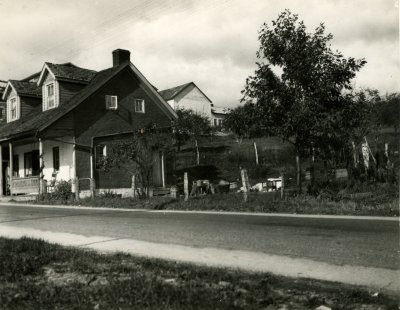
Courtesy of the Enoch Pratt Free Library, Central Library / State Library Resource Center, Baltimore, Maryland
I found this photograph, taken by the Maryland State Department of Forestry, in November of 1936, which helps explain what happened. The road was widened, and rather than move the building, the porch was eliminated. With the porch present, the dimensions of the toll house seem more appropriate with one would expect of a structure from this region and time.
Also note that the toll house originally had gutters. It seems that the present lack of them may eventually cause structural issues for the building. In addition, they seem to tie together the visual appeal of the tollhouse.
I'm torn, as a historic preservationist, whether to advocate having the building moved and returned to its original state, or to advocate leaving it in its original location. I'd love to see the road moved, but that is almost impossible. Perhaps a historical marker, from a vantage point similar to the one above, showing it as it was, would help illustrate the situation.
Old Photographs from the Maryland Department, Enoch Pratt Free Library
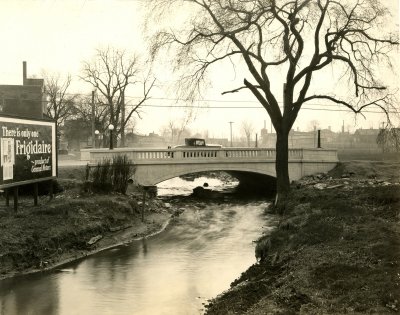
New Carroll Creek Bridge, East Patrick Street, Frederick, Maryland, 1926. Photograph by the Maryland State Roads Commission. Courtesy of the Enoch Pratt Free Library, Central Library / State Library Resource Center, Baltimore, Maryland
I've just uploaded more than 100 black and white photographs, virtually all of them taken between 1900 and 1940, relating in some way or another to the National Road in Maryland. The photographs are from the Maryland Department of the Enoch Pratt Free Library, in Baltimore, Maryland. Many of them were taken by the State Highway Administration, documenting construction and realignment of roads and bridges. Others were taken by the Historic American Buildings Survey, documenting historic structures on or near the National Road. Still others were taken by the Maryland National Guard, providing aerial views of various Maryland towns along the National Road. Finally, some were taken by private individuals, but are old enough that they have passed into the public domain.
I will be writing more about the individual photographs in coming weeks, as well as providing maps and detail descriptions. Expect the descriptions on the individual photograph pages and other metadata to increase.
Wednesday, February 27, 2008
The National Road, Most Historic Thoroughfare in the United States, and Strategic Eastern Link in the National Old Trails Ocean-to-Ocean Highway
I recently had the fortune to find a copy of Robert Bruce's classic 1916 title on the National Road with the binding in rather sad condition. Bruce originally wrote the book as a set of nine articles for the AAA. They were later published together by the Brooklyn Eagle Press, in 1916. I've taken the liberty of scanning it, in its entirety.
The book includes history, photographs, driving directions, and an extensive collection of maps showing the route of the National Road and adjoining routes.
The book includes history, photographs, driving directions, and an extensive collection of maps showing the route of the National Road and adjoining routes.
Wednesday, February 20, 2008
Middletown, Maryland

The National Road forms the Main Street in Middletown, a small town, west of Frederick, Maryland. It is seen here from the east edge of town, looking west.

The Middletown Memorial and Town Hall is a wonderful historic building. Someday, some good person will remove the utility lines so that a better photograph might be created. It appears to be unused at the present.
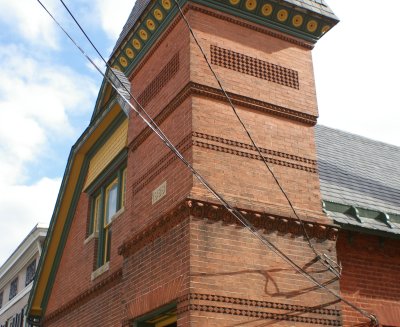
It is unclear what purpose this brick building, built in 1888, originally served. Now it appears to be a private residence.
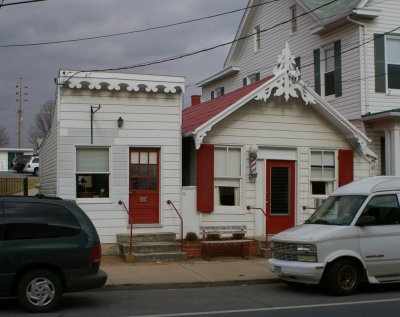
These buildings make a curious pair. One is (or was) a barber shop, but the original use of the other is not obvious.
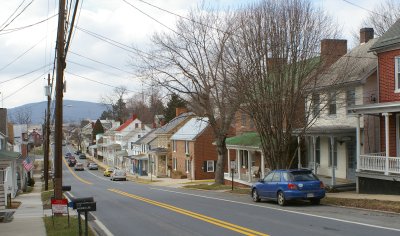
As one travels west, the buildings become primarily residential.
Two stone arches for the price of one
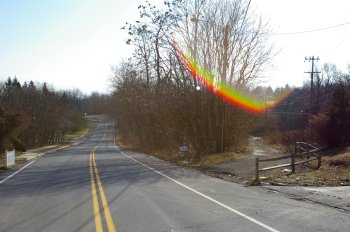
Just east of Mt. Airy, Maryland, is Parrsville. This rarely visited section of the National Road was cut off by the construction of Interstate 70. Both of the roads shown in this picture are actually sections of the National Road. The one that looks almost like a driveway was for an at-grade crossing of the Baltimore and Ohio railroad, which was replaced by a bridge, the road on the left, in the 1920s.
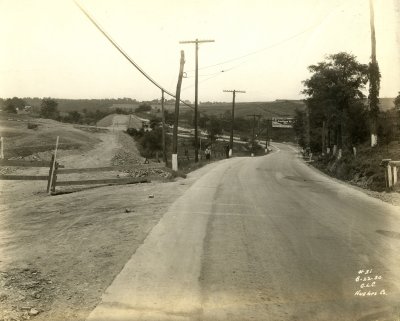
This photograph, taken in 1930 by the Maryland State Roads Commission, was taken from a similar angle to the one above. It shows the construction of the new alignment, on the left. Courtesy of the Enoch Pratt Free Library, Central Library / State Library Resource Center, Baltimore, Maryland.

From the train tracks, looking west, the remains of the older alignment and a church are visible. It also seems to have become a dumping ground for trash.
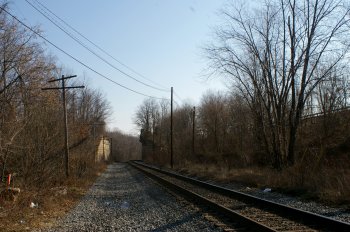
From the same spot, looking to the northeast, the bridge that used to carry the National Road over the B&O can be seen. The guardrail on the right is for the westbound lanes of Interstate 70.

I didn't think much of this old alignment until I looked over and saw this stone culvert. The construction of it is different from what I am used to seeing - the stones are longer, and the construction is more precise. To the right of this stone arch was a larger one, 20 feet wide, that, for some time, carried the B&O over the National Road.

The other end of the culvert illustrates the nature of the construction a bit better. According to B&O RR Photo Tours, this culvert carried an old route of the B&O during the 1830s, before the route was changed. It's amazing that this stone structure has (mostly) held up for 170+ years with no maintenance whatsoever. The B&O really built things to last.
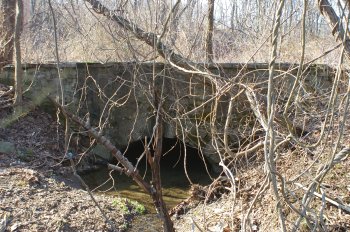
From the point where I first photographed the B&O culvert, I noticed something else, on the old National Road alignment - another stone culvert! This photograph was taken from virtually the same position as the vertical one of the B&O culvert. It has held up reasonably well, though it wasn't always so covered with debris.
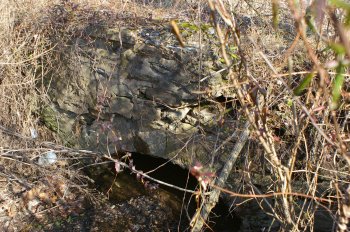
The south side of the culvert hasn't fared as well.
Other National Road blogs
I somehow missed this update from Jim Grey, Indiana and Illinois National Road Revisited. I love that the state had the foresight(?) to have a sign ordering people to not remove bricks from the old alignment.
You might also be interested in Patricia McDaniel's National Road travel journal.
You might also be interested in Patricia McDaniel's National Road travel journal.
Friday, February 15, 2008
Casselman River Bridge postcard
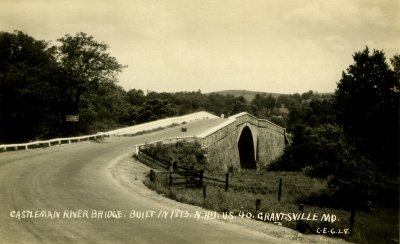
So, someone occasionally spends a bit too much time on eBay. I just got this nice postcard, so I made a high resolution scan and thought I'd share it. It shows the Casselman River Bridge, a National Historic Landmark on the National Road, east of Grantsville, Maryland.
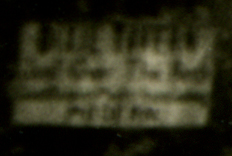
This sign, on the trees to the left of the bridge, is for the Dixie Tavern.

This sign is just before you cross the narrowest part of the bridge. It reads "No parking opposite white line."
Subscribe to:
Comments (Atom)
